Introduction: Gena Philibert-Ortega is a genealogist and author of the book “From the Family Kitchen.” In this guest blog post, to help celebrate Mother’s Day this weekend, Gena provides genealogy search tips to find information about your female ancestors.
There’s no doubt that tracing female ancestors can be difficult and sometimes near impossible. Unlike men who were documented via different types of transactions throughout their lives, women can seemingly disappear just by marrying an unknown-to-you spouse or spouses.
Let’s face it, finding a certified Mother of the Year might be easier than finding most of our female ancestors, but consider the following genealogy search tips to help you find success as you embark on your family history research.

Finding Dear Old Mom in the News
First, consider the relationship your ancestress had to others. She may have been a wife or several men’s wife. Maybe she was a mother and a grandmother. Likely as a younger woman she was a student, perhaps a volunteer, and a church or organization member. Don’t forget that she was also somebody’s daughter and friend. She can be in all kinds of different newspaper articles based on her activities and relationships at the time.
As you consider all this, remember that her name will “change” according to her relationship and time. A non-married woman will be listed by her given name and surname (a.k.a. maiden name), while a married woman might be listed as Mrs. [insert husband’s first name or initials and surname]. A widow may revert back to using her given name, so that Mrs. John Smith or Mrs. J. W. Smith becomes Mrs. Grace Smith after his death.
An example of this is the obituary for Mrs. Emily Ann Smith, a widow who was living with her daughter Mrs. W. E. Gilchrist when she died. Note she is not referred to as “Mrs. Sanford Smith.”
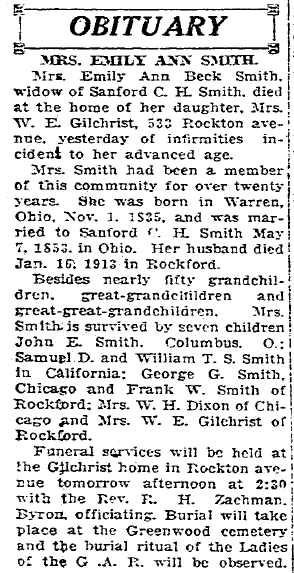
Rarer is a news article such as this next one, in which the deceased is referred to by both her own name (Mary Smith Keenan) and her married name (Mrs. James Keenan). Because this is rare, make sure that you are searching all variations of a female ancestor’s name—because some articles will have her name one way, and some will have it another; very few will have both versions.
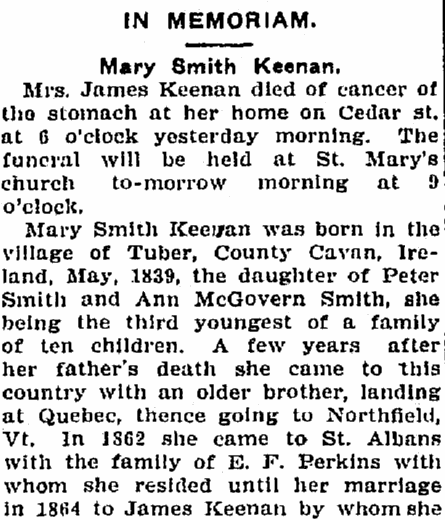
Start Research with the Basics
As you research, use a timeline of dates and places to help you find newspaper articles that you may miss just searching by a name, due to misspellings or name variations. Find the corresponding newspaper articles for your timeline that document the major events in her life: birth, engagement, wedding, children’s births, major anniversary milestones, and death.
This engagement notice from 1939 for the appropriately named Mary Love Jones gives great information—not only about her but other women in her life: her mother, sister, aunts, and other family and friends. Note that not all of the women are listed by their given names. Plus, this article provides a photograph of Mary as a young woman—what a great find if she’s one of your ancestors!
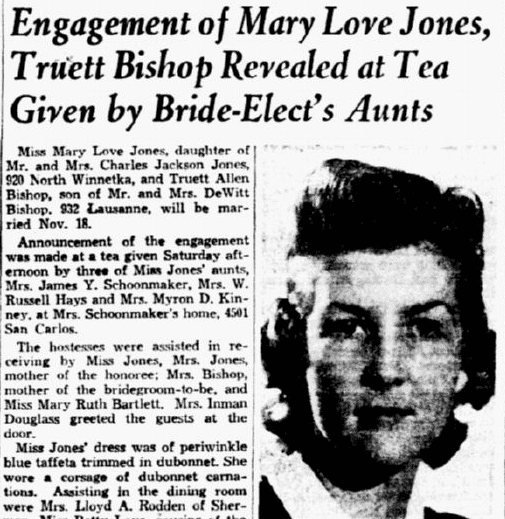
Avoid Making Assumptions about Your Female Ancestors
Stay away from making assumptions about your ancestor’s life. Don’t fall into the old “she was just a housewife” syndrome. You might be surprised to find what she was involved in during her lifetime.
For example, I love this front page montage of photos of teachers and women from the local PTA of Greensboro, North Carolina. What a great find for a descendent who may not be aware of their ancestor’s school involvement.

Another great example of “women’s work” making it into the newspaper is this article about Red Cross volunteer Mrs. D. P. Beyea, who spoke to groups about her experience nursing soldieries overseas during World War I. Known as the “Little Mother of the First Division,” she is said to have been one of the first to volunteer. You get a sense of her accomplishments from the newspaper article and a reminder that a woman’s activities may have depended on the time period.
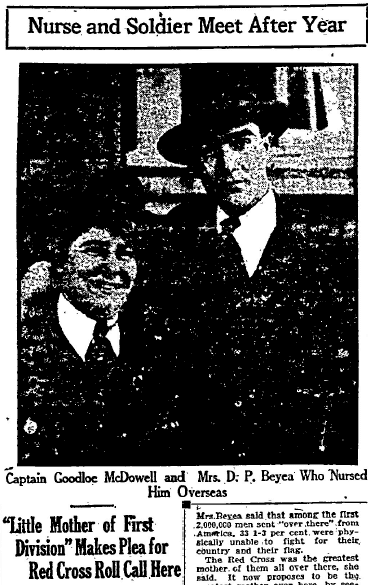
Again, the issue of name is important here. The old news article isn’t clear whether D. P. (later listed as D. Pirie) is her husband’s initials or her own. A newspaper search on just one version of her name might easily miss this informative article.
Use Clues in Newspaper Articles to Find More Information
Continuing our genealogy search for Mrs. D. Pirie Beyea by searching Google, we can learn even more about her life. For example: click here to see a copy of her lecture brochure digitized and made available through the University of Iowa Libraries Digital Library. This is a great brochure complete with personal information, charming photos, and testimonials by those who heard her speak.
Genealogy Search Tip: Once you find your ancestor listed by a certain name or involved in an activity in GenealogyBank’s Historical Newspaper Archives, make sure to continue your search in Google and Google Books for any other mentions of them.
Consider Your Ancestor’s Activities
It’s hard to know what activities your ancestor may have been a part of since some groups that would have been familiar in her time are all but unknown today. Consider that she may have been a member of a group that was an auxiliary to one her husband was a member of (The Daughters of Rebekah, Order of the Eastern Star, Ladies of the Grand Army of the Republic), a religious benevolent group (Dorcas Society, Relief Society), a cause she believed in (Women’s Christian Temperance Union, National American Woman Suffrage Association), a heritage association (Daughters of the American Revolution, Colonial Dames, Daughters of the Confederacy), or just a local group that may have done anything from hold cultural events to provide a social outlet. These groups may have had articles published in the newspaper that listed members or officers, meetings, special events, or persuasive missals.
The following newspaper article reports on the Spinsters, a social group for young unmarried women.

The historical news article above is from this newspaper’s “Women’s Activities” page which has some great articles about women’s groups, wedding notices, and personals that list names of women and mentions of vacations and visits.
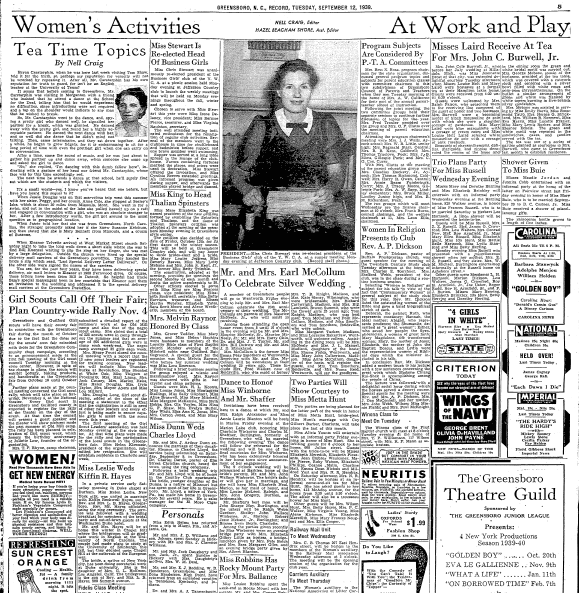
There’s So Much Genealogy to Explore
Having trouble finding genealogical information about your foremothers? Newspaper collections are an excellent place to start because newspapers recorded the happenings of a community. Can’t find anything about your female ancestors? Remember to search the archives for your ancestress with applicable name variations—and keep checking back: GenealogyBank adds more newspapers daily. Even though you may not find anything about your ancestry today, tomorrow could reveal your “aha” genealogy moment.
Happy Mother’s Day!
Related Articles about Tracing Your Female Ancestry:
- A Good Woman Can Be Hard to Find
- Newspaper Recipe Contests: Was Your Ancestor a Contest Winner?
- Women during World War II: Knitting & Sewing on the Home Front
- Find Your Female Ancestors This Women’s History Month
- Early Women Occupations, Jobs & Avocations
- Find Grandma’s Recipes in Old Newspaper Food Columns
- Earlier Women of War: Nurses, Camp Followers & Red Cross Volunteers
- 8 Genealogy Tips for Tracing Female Ancestry
[bottom_post_ad]

Foremothers